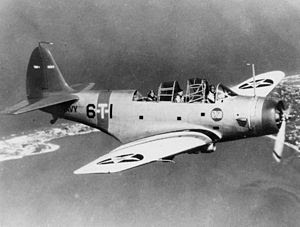
USS Hornet - 1939
Reacting to an early morning sighting of Japanese invasion forces off the island of Midway, Rear Admiral Raymond A. Spruance (a last minute replacement for Vice Admiral William "Bull" Halsey, sent to the hospital for treatment of a bad case of psoriasis) orders an immediate strike on the Imperial fleet. The elements of the strike though are fatally uncoordinated ... despite protests from VT-8 Lieutenant Commander John C. Waldron, the Hornet's fighters stay high to protect the ship's dive bombers (a bad decision agreed to by Spruance and Commander Stanhope C. Ring), and compounding matters even further, they follow a wrong heading to the west and never make contact with the enemy fleet.

Waldron
The forty-one-year-old Waldron, a 1924 graduate of the U.S. Naval Academy, however disagrees with the path taken, turns to the southwest once in flight, and at 9:20, finds what he has been seeking ... the four aircraft carriers of Admiral Chuichi Nagumo's command ... Akagi, Kaga, Soryu, and Hiryu ... all veterans of the December 7th surprise attack on Pearl Harbor.

Nagumo
Unescorted and inexperienced, Waldron's group is also highly disadvantaged by the weaponry they take into the battle ... fifteen obsolete, three-man Douglas TBD Devastator torpedo bombers (soon to be replaced by the Grumman TBF Avenger) ... all carrying defective Mark 13 torpedoes. Slow, barely maneuverable, with light defensive weaponry and little armor ... the American planes stand little chance of success, but drop down and begin their torpedo runs anyway.

Devastator
The group's only plus is its fighting spirit, as personified in their leader. As if in possession of a magic crystal ball that shows him how the battle will go, the night before their moment in history, Waldron tells his men, "If there is only one plane left to make the final run-in, I want that man to go in and get a hit. May God be with us all. Good luck, happy landings, and give 'em hell."

Waldron On His Way
But for Torpedo Squadron 8 their will be no happy landings, only watery crashes. Making their runs, the group is swarmed by Japanese fighter aces flying Mitsubishi A6M Zeros ... and one by one, in a matter of minutes, all fifteen Devastator are shot down without a single torpedo hit being scored. Fifteen planes, thirty men, and there will be only one survivor ... Ensign George Gay.
 Torpedo Squadron 8
Torpedo Squadron 8
L-R Top: James Owens, William Abercrombie, Waldron, Raymon Moore, Ulvet Moore, William Evans, Grant Teats, George Cambell
L-R Bottom: Harold Ellison, Henry Kenyon, John Gray, George Gay, Jeff Woodson, William Creamer, Robert Miles
Wounded attacking the Kaga, after dropping his torpedo, Gay evades anti-aircraft fire by flying aft over the carrier's busy flight deck (where a multitude of planes are having their ordinance changed for an attack on the American carriers). He can't evade the five Zeros though that jump him as he pulls away from the carrier ... and cannon and machine gun fire hits from all sides put Gay's plane in the Pacific. Hiding under a seat cushion to avoid strafing attacks from the Japanese fighters, or capture by one of the passing ships of the Imperial task force until he can inflate his life raft, Gay will spend 30 hours in the water before being rescued by a Consolidated PBY Catalina flying boat. In the water, he will also have a ringside seat from which he watches what follows the sacrifice of his squadron.

Gay (R) and his rear gunner, George Field
A sacrifice which is not in vain ... because of the attack the Japanese are not able to launch their own counter-strike on the American carriers, leaving their decks covered in planes, bombs, and aviation fuel. Additionally, the attack brings down, scatters, and depletes the fuel and ammunition of the Zeros on combat air patrol over their ships at just the right moment, as the SBD dive bombers of the Enterprise and Yorktown arrive directly over the enemy fleet. Bombing runs made without interference, in a little more than six minutes the Kaga, Akagi, and Soryu are turned into flaming hulks by the American aviators.

Turning Point In The Pacific
Invasion blunted, the "miracle" at Midway, America's impossible victory, allows the United States to go on the offensive at Guadalcanal, and the triumph at Guadalcanal in turn allows the island hopping campaign to move across the Pacific until it finally stops in Tokyo Bay aboard the battleship USS Missouri ... compliments of the sacrifices, like those of Torpedo Squadron 8, that were made by all those that fought at Midway on this day in 1942 ... may we never forget them.
Victory Ceremony - Tokyo Bay - 1945
No comments:
Post a Comment